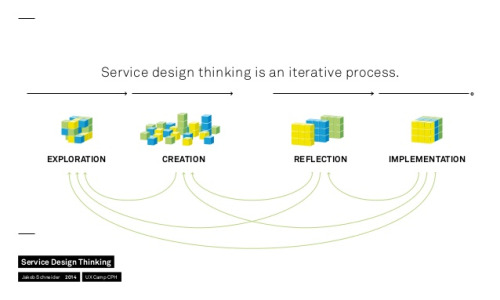Service Design Thinking
Originally published on Smaply Bits June 1st, 2016.
Service Design or Design Thinking is often linked with terms, such as innovation (process), change, and improvement. How can Service Design Thinking be integrated in an organization as a mean of change?
“Most people make the mistake of thinking design is what it looks like. People think it’s this veneer—that the designers are handed this box and told, ‘Make it look good!’ That’s not what we think design is. It’s not just what it looks like and feels like. Design is how it works.” — Steve Jobs
Think Different
Service Design became more and more popular over the last years. Service Design refers to innovating both tangible products and services and is nowadays used, to connect people and technologies across multiple channels. The boundaries between physical products and services are blurring and mostly one doesn’t exist without the other anyway. We need to think in systems and understand the ecosystem in which services and physical products operate.
Service Design is based on an iterative process that helps to organizations to innovate. Applying service design in an organization or project is not a yes/no decision. Often teams start with using only a few tools or methods in a first project. Thy learn how to adapt the process and language to their own organizational culture. Over time and often several projects more and more people in an organization build up competence through workshops, masterclasses, jams, conferences, talks, and so on. At some point organizations often start to define a common language and approach that allows teams from different departments, regions, countries to use a common language. Such as minimal common process and toolbox allow disperse and diverse teams to work together efficiently. In the end, some organizations strive to include service design in their DNA, affecting their entire corporate culture.
Labels and Processes
Different agencies, organizations and countries use different labels for more or less the same thing. We don’t care if you call what we’re doing Service Design, Design Thinking, Experience Design, UX or CX Design, to name but a few. Instead of building up new silos what design is and what now, we should focus on breaking down silos within organizations. In this article, we’ll call it service design, but please change the words against whatever you like…
Service Design follows an iterative design process. The following process is just a framework and not a how-to guide. In fact, the very first step of a service design process should be to design the process itself. Every agency and organization uses a different process with different naming. However, there’s a common basic idea behind all of these.

The Iterative Process of Service Design
Imagine the process of designing by the example of a car. It might start with market research to discover what kind of car potential customers would prefer. Obviously, if there is a market for a product, it is worth designing. Based on these explorations, designers start creating ideas and the first design concept is born. Prototypes are built and tested in terms of usability, functionality, cost, market response and so on. Only if these test remain positive, the new car will be produced and launched. Mistakes during this process will lead to enormous costs or even reputational damage. As this simple example illustrates, a well-thought-out approach to the design of a new precepts is crucial for it’s lasting success!
The iterative four steps of exploration, creation, reflection and implementation are a very basic approach to structure a complex design processes that actually consists out of many loops (iterations). Let’s go through these four steps a bit more in detail:
Exploration (aka Discover or Research)
Although service design is a user-centered (or customer-centered, human-centered) process that often claims to start with the customer and puts them at the centre of its process, service design seldom starts with the customer. The first step is to learn the culture, structure and goals of the company that provides a service. As part of this first step, it is also important to challenge the initial briefing, the design challenge a team received. Often the problem a team is asked to solve is only a symptom and not the real cause that should be solved.
“It is important to keep the big picture and as far as possible, ascertain the true motivations behind customer behavior”. — TiSDT
Collecting empirical data is a step in the right direction. Service design uses lots of different methods and tools to explore and understand the behavior of all people involved. Especially ethnographic approaches haven been adopted as one of the most commonly research approaches in service design. Exploration also includes to visualize the findings and to make sense of the collected data. Visualizing data as personas, journey maps, stakeholder maps, etc. helps a team to simplify complex processes and makes it easier to understand wich problems should be actually tackled.
Creation (aka Ideation or Concept Design)
In order to achieve sustainable solutions, it is crucial to include all main stakeholders and work with teams that include customers, employees and management, as well as engineers and designers. The main aim is to work in a co-creative manner.
Keep in mind, that Service design isn’t about avoiding mistakes, it’s about exploring as many ideas as possible, identifying problems as early as possible in order to learn from them. Prototyping ideas very early in the process in a fast and open way is much better than just discussing ideas.
Reflection (aka Prototyping or Testing)
This stage is about iterative prototyping and testing many different ideas and concepts. It is rather straightforward to test physical products, but when it comes to testing intangible services or whole systems of products and services, you cannot simply put a service on a table and ask customers what they think about it. Even using feedback methods such as surveys or interviews come with strong biases. Customers need a good mental picture of the future service concept. Generating such a vision of a service concept in the mind of customers is the task at this stage.
In this context, we need to consider the emotional aspects of a service. Videos, photos, storyboards etc. help to generate the necessary emotional engagement but still lack meaningful user interaction.
“It is important to prototype service concepts in reality. Service Design Thinking uses different stages and interactive approaches.” — TiSDT
“Playing” through certain situations helps to incorporate emotionally important aspects of personal interactions with the service proposition.
Implementation (aka Roll-out or Change Management)
The implementation of new service concepts demands a process of change. There are three principles of change management you can consider as a guideline: planning change, implementing change and reviewing change. Every implementation should be tested as well during the previous stages. A clear communication of a concept to your team is essential and needs to include the desired customer expectations.
Besides customers, your employees play the most important role in the process. Their motivation and engagement is crucial for sustainable service implementation. Include employees in your design process from the very beginning. Focus on their employee experience as much as you focus on the desired customer experience. Give your employees the chance to deliver ideas and involve them in every step of the process.
At an organizational level it is important to monitor the processes. Service blueprints are one of the standard methods to illustrate internal and external backstage processes. There will always occur some unexpected aspects that create frictions, but the more resources are invested in the earlier stages, the more likely is a smooth transition.
How to Win Stakeholders & Influence Decisions program

Gain the power skills you need to grow your influence on critical product decisions.
Get mentored and coached by Jared Spool in a 16-week program.
Learn more about our How to Win Stakeholders & Influence Decisions program today!

